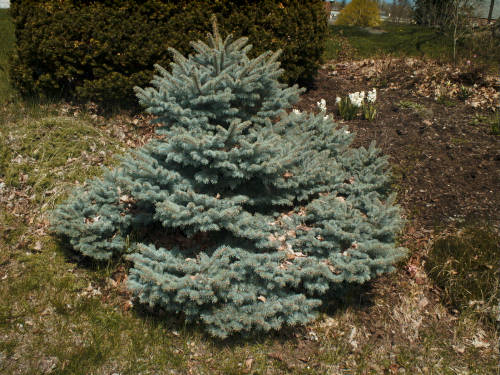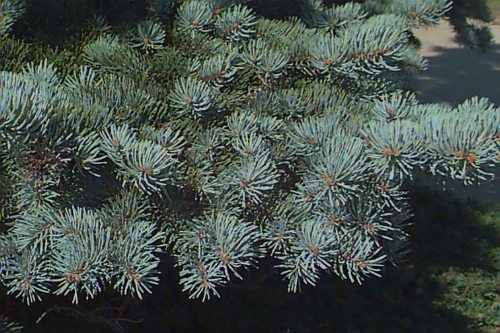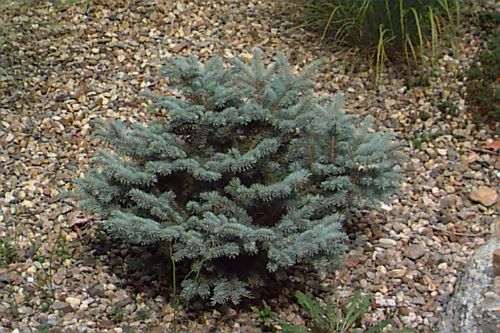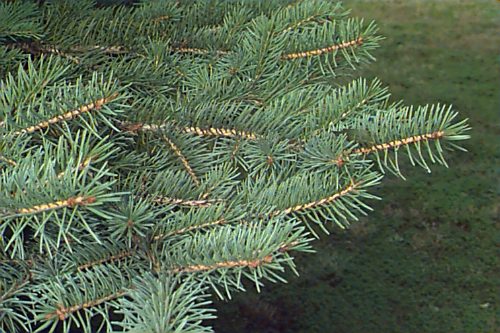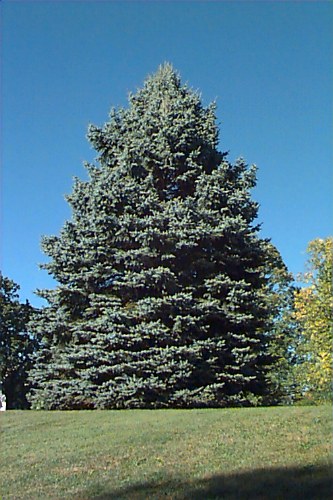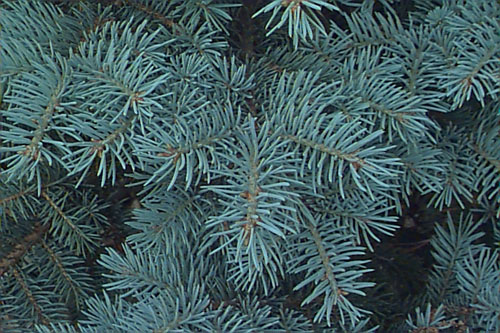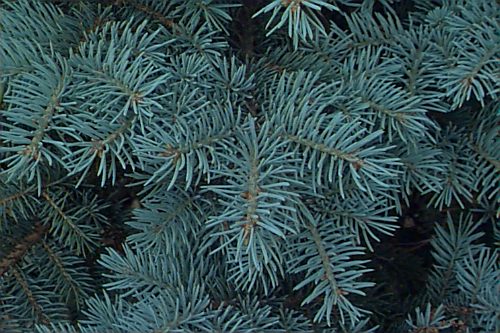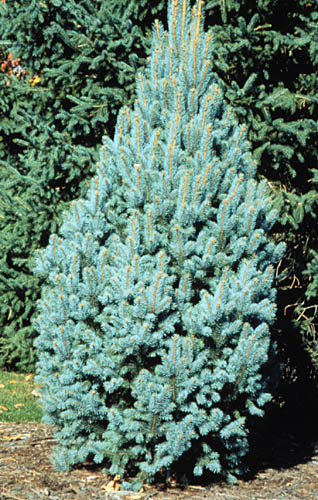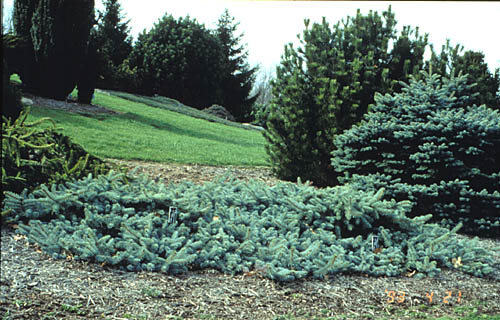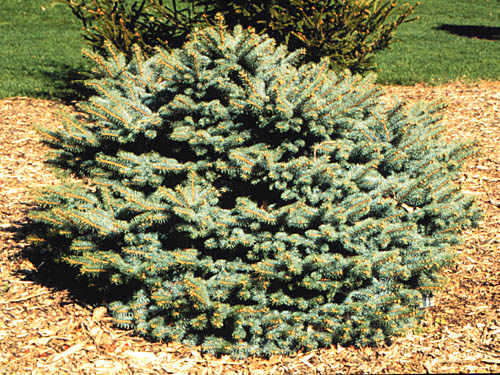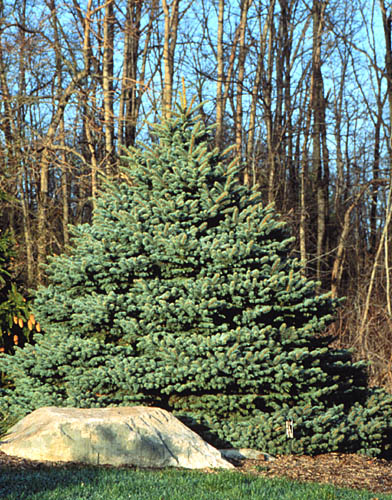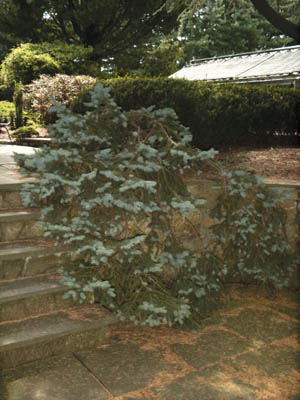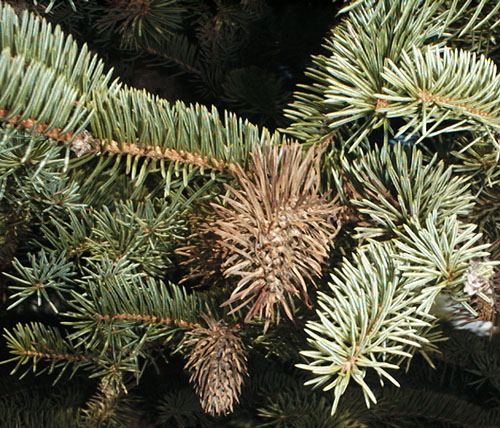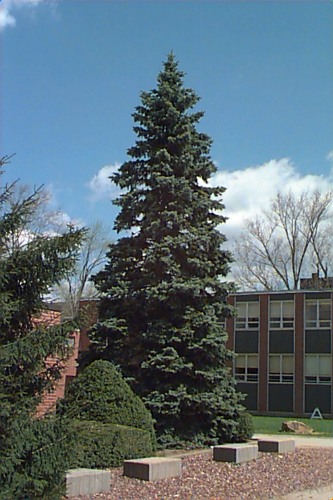Picea pungens
Colorado Spruce
Pinaceae
ExpandHabitat
- native to southwestern United States
- zone 3
Habit and Form
- evergreen tree with horizontal, stiff branches
- branches tend to go to the ground
- narrow, dense, conical shape
- conical shape opens with age
- 30' to 60' tall , can reach 120'
- 10' to 20' spread
- slow growth rate
- medium texture
Summer Foliage
- needles are spread around stem, with more located above stem then below
- needles are four sided with 6 stomatal lines on each side
- needles are 0.75" to 1.25" long
- needles are very stiff and rigid
- blue green to green color
Autumn Foliage
- no fall color, evergreen
Flowers
- monoecious
- not ornamentally important
Fruit
- mature cones are cylindrical and pointed at each end, up to 5" long and about 1" wide
- violet color turning to a medium brown at maturity
- cone scales are wavy
- cone tip is blunt and jagged looking because of wavy scale margins
- cones are held on short stalks
Bark
- gray brown color
- blocky
Culture
- prefers organic, moist soil
- very adaptable
- somewhat drought tolerant for a spruce
- full sun
Landscape Use
- specimen (blue needled)
- screen
- large shade tree when an evergreen is desired
- groupings or mass planting
Liabilities
- spruce gall aphid, cause branch tip die back
- spider mite
- needle color variation
- pointed needles are very sharp
- branches all the way to the ground
ID Features
- large, narrow, evergreen tree
- long cones with wavy scales
- needles leave petiole on stem when pulled off
- needles that are 4-sided
- green to blue-green color
- stem tip dieback from spruce gall aphid
Propagation
- by seed, requires no treatments
- cultivars by grafting or some by cuttings
Cultivars/Varieties
f. glauca (also known as var. glauca) - These are natural variants (seed grown plants) with a degree of bluish foliage. This trait is very variable, and most blue-leaved cultivars are merely asexually propagated selections of this form.
'Fat Albert' - A bright blue-needled selection, this plant is notable or its short, squat pyramidal habit to 15' tall. When young, it can appear very wide and rounded.
'Glauca Pendula' (also listed as 'Glauca Procumbens', 'Procumbens', 'Glauca Prostrata' and 'Prostrata') - These forms are rather shapeless plants that sprawl over the ground like a groundcover. The needles are usually a good blue.
'Hoopsii' - Perhaps the cultivar with the strongest blue color, this selection forms a neat, upright tree.
'Iseli Fastigiata' - This is an upright, narrow clone with strong blue foliage. It resembles a blue pillar.
'Iseli Foxtail' (also called 'Foxtail') - The needles at the tips of new branches are much shorter than those at the base, thus the stems resemble "foxtails". The needles are blue and the plant becomes an open tree. This selection may adapt better to hot summers than other forms.
'Koster' (also listed as 'Kosteri') - This is an older blue-foliaged selection, not as preferred by horticulturists due to its unpredictability and lack of uniformity between plants.
'Moerheim' (also listed as 'Moerheimii') - A dense-growing tree to 30' tall, this plant maintains good blue foliage color. It in often irregular when young and requires time to develop its upright tree habit.
'Montgomery' - A conical form with a dense, globular shape, this plant has silvery-blue needles and is popular in commerce.
'Pendula' - With training, this selection forms an upright tree with cascading growth. It can also be allowed to grow prostrate as a groundcover. The needles are bluish in color.
'Thompsenii' (also listed as 'Thompsen' and 'Thomsen') - This is a pyramidal tree similar to 'Hoopsii' with bright blue needles that are very thick in texture. It forms a pryamidal tree. It is considered one of the best selections available.
